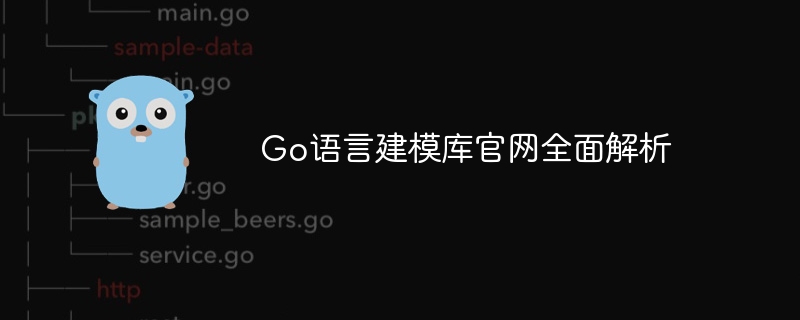Home >Backend Development >Golang >Comprehensive analysis of the official website of Go language modeling library
Comprehensive analysis of the official website of Go language modeling library
- PHPzOriginal
- 2024-03-01 11:12:03575browse

Go language modeling library official website comprehensive analysis
As a fast and efficient programming language, Go language is welcomed by more and more developers. In the Go language ecosystem, the modeling library is a very important component, which can help developers quickly build and manage data models and improve development efficiency. This article will delve into the official websites of some popular Go language modeling libraries, including their functional features, usage methods, advantages and disadvantages, and help developers better choose a modeling library that suits their project needs.
1. GORM
GORM is a popular Go language modeling library. It provides powerful functions and flexible interfaces to help developers quickly operate databases. GORM's official website provides detailed documentation and sample code so that developers can get started easily. Its main features include:
- Supports multiple databases: GORM supports multiple databases, including MySQL, PostgreSQL, SQLite, etc., and can flexibly choose the appropriate database type for different projects.
- Automatic table creation: GORM can automatically create corresponding database tables based on Go language structures, greatly simplifying the database operation process.
- Associated query: GORM supports associated query, which can easily query the associated information between multiple tables.
- Chain operation: GORM provides a chain operation method, which can flexibly construct query conditions to meet different query needs.
Although GORM is powerful, it also has some shortcomings. For example, the support for some advanced database operations may not be complete enough, and sometimes manual SQL operations are required. In addition, some complex data structures may be difficult to operate.
2. XORM
XORM is another commonly used Go language modeling library. It also has rich functions and flexible interfaces. XORM's official website provides detailed documentation and sample code so developers can get started quickly. Its main features include:
- Supports multiple databases: XORM also supports multiple database types, and you can choose the most appropriate database for different projects.
- Rich query interface: XORM provides a rich query interface to meet various query needs.
- Transaction support: XORM supports transaction operations, which can ensure the atomicity of database operations and ensure data consistency.
- Automatic mapping: XORM can automatically map Go language structures to database tables, reducing manual mapping work.
However, XORM also has some shortcomings. For example, the support for some emerging databases may not be sufficient and you need to wait for updates. In addition, some complex database operations may require developers to write native SQL statements.
Taken together, both GORM and XORM are excellent Go language modeling libraries, each with their own characteristics and advantages. Developers can choose a suitable modeling library based on their project needs and preferences to improve development efficiency. At the same time, it is recommended that developers carefully read the official documentation when using the modeling library to master its functions and usage to ensure the smooth progress of the project.
In the future, as the Go language ecosystem further grows, the functions of the modeling library will continue to be improved and expanded to provide developers with more convenience. I hope this article will help developers understand more and choose a suitable Go language modeling library.
The above is the detailed content of Comprehensive analysis of the official website of Go language modeling library. For more information, please follow other related articles on the PHP Chinese website!
Related articles
See more- lol cannot connect to the verification service, please go to the official website to check the server status
- What is the official website address of Band of Brothers PHP training?
- How to update one table with another table through SQL statement
- How to query slow sql statement in mysql
- How to install Windows 10 official system on Asus computer

